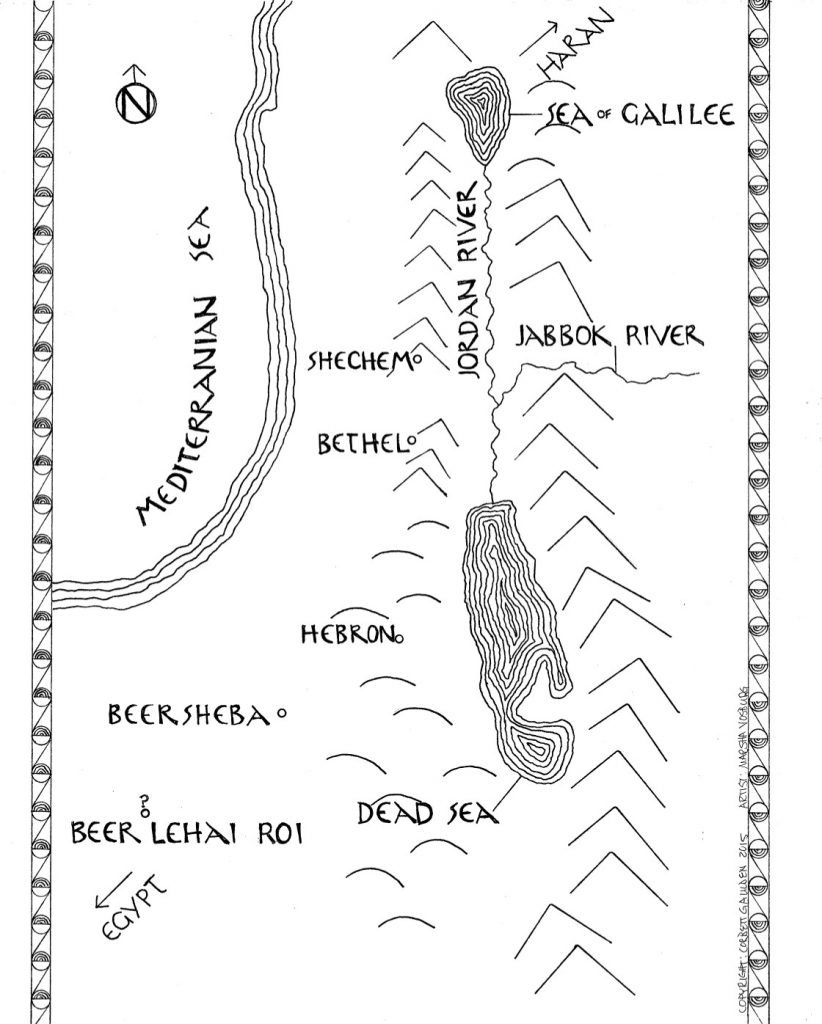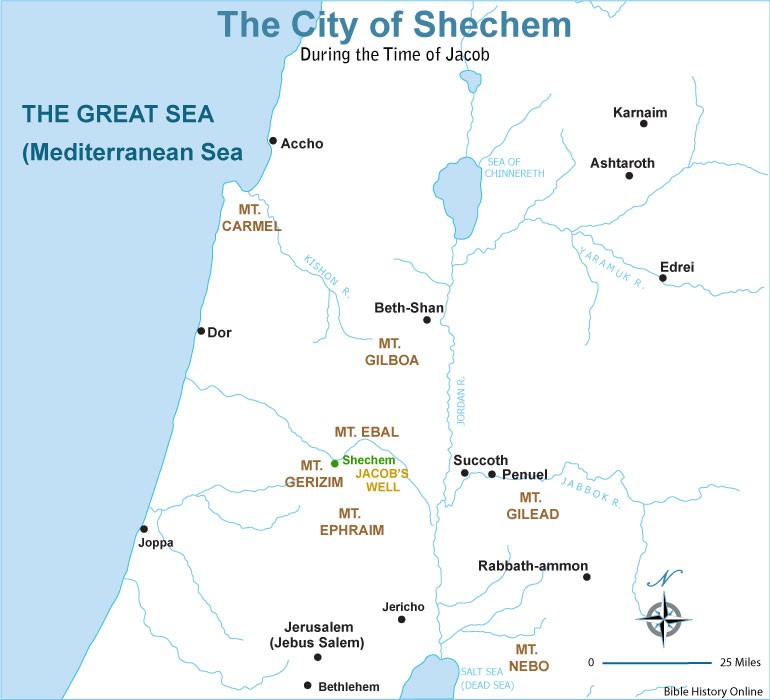Patriarchal Places in Birth of The Holy Nation
This is an expanded appendix associated with the book,Birth of The Holy Nation, Volume 1. by Corbett Gaulden. Certain matters were not appropriate for inclusion in the book at the time of publishing. Other matters will emerge over time that are appropriate for this appendix. This will become a repository for such concerns as they emerge.
The discussions of the patriarchal places that are provided below are included in the printed form of the book. As other, supplemental materials are found appropriate for development, they will occur in this space. Over time it is expected that our information and knowledge will be extended and we will use this space to indicate such things.
In addition to the discussions of the five patriarchal places provided below, we have developed a map of the area in question with the approximated place names indicated. It is hoped this will help orient the reader. Click on the image to see an enlarged version of the map.
A link is also provided for a somewhat lengthier discussion of the city of Shechem and its place in the bible in addition to the patriarchal narrative:
Appendix in the Printed Book
The national patriarchs (Abraham, Isaac and Jacob) were nomadic characters. This means, among other things, that they moved about from place to place. The regular movement was necessary because of their pastoral economy. While they did move regularly, the biblical text names only five cities that we may consider to have been “home-places” for them. These cities are likely to have been centers of their activities for much of the year. They probably even built some permanent structures in those places. However the evidence indicates they actually lived in tents. These places, in some cases, had Canaanite populations with whom the patriarchs formed economic and social alliances. They do not seem to have become dependent on these places but did seem to return to them often and use them as “addresses” at different times. These five cities were: Shechem, Bethel, Hebron, Beersheba, and Beer Lehai-Roi. The list is a north-to-south list and also a chronological list. In other words, Shechem is farthest north and the first to figure in the Canaanite period for the patriarchs. Beer Lehai-Roi was the furthest south and was the last (and probably the least significant) of the cities.
Shechem
Shechem was the point of initial arrival in Canaan for Abram/Abraham. When Abram arrived at Shechem, he seems to have stayed for some short while and to have built one of his altars there.
The next significant event was the arrival of Jacob after his Aramaen adventures. He was a “native” of Canaan, but left to avoid his brother’s wrath and to find wives for himself. When he returned to Canaan, Shechem was the first major dwelling for him. He acquired property near Shechem. It was at Shechem that his sons Simeon and Levi so seriously offended him in the murder of the men of Shechem after the rape of their sister Dinah.
It was also to Shechem that Jacob sent Joseph in search of his older brothers. On this venture, the brothers seized Joseph and sold him into slavery.
Scripturally, Shechem is not associated with Isaac.
In the later history of the Israelites, Shechem became one of the cities of refuge and lay in the territory of the tribe of Ephraim. (Joshua 20:7)
Joshua held a national conference at Shechem. (Joshua 24) probably because of its nearly central location.
Judges 9 contains the history of the wicked man, Abimelech, who was a son of Gideon and reflects on the wicked character of the citizens of Shechem, which was the home town of Abimelech.
Rehoboam the son of Solomon was crowned king in Shechem. (1 Kings 12:1). Jeroboam took Shechem a short time later and it figured as a fortified city of the northern kingdom thereafter.
Below is an image of the City of Shechem. Click on the image to see an enlarged version of the map.
Bethel
When Abram left Shechem a short time after arriving in Canaan, his next listed campsite was at a place that came to be called Bethel. Based on the passage in which Jacob assigned the name to the place, it does not seem that Abram or the Canaanites gave Bethel its name. (Genesis 28:19). There was a place name nearby that was called Luz, assumedly a Canaanite town.
Not too long after Abram arrived in Bethel, a famine occurred in Canaan. The famine was of such severity or duration that Abram and his camp packed up and moved to Egypt, assumedly to escape the hardships of the famine. After the short sojourn in Egypt, from which he was expelled, Abram returned to Canaan and came to Bethel for another stay. It was while Abram was at Bethel for what was probably a significant amount of time, he and Lot were forced to come to terms that the pasturage of the area was inadequate to support all their herds and flocks. From here the split between the two of them occurred. Lot went down to the low country and settled in the vicinity of Sodom and Gomorrah. As we know, these two cities were eventually destroyed and are probably under the Dead Sea today. The valley was quite lush and Lot chose to go down there. At the time of the parting-of-ways, Abram accepted Lot’s decision and moved up into the higher country near a place we now know as Hebron to be discussed below.
The next prominent occurrence of Bethel in the patriarchal story is associated with the flight of Jacob from the wrath of Esau. At the time of that flight, it appears the family of Isaac lived in the area of Hebron by the way. At Bethel, the LORD visited Jacob in a particularly powerful dream that we often call “Jacob’s ladder.” Subsequent to that dream in which God mad particular promises to Jacob and Jacob responded with particular vows, Jacob set up a pillar in the place and gave it its name.
We know that Jacob returned twenty years later, his second main encampment took place at Bethel.
A king of Bethel is listed among the defeated Canaanite kings in Joshua 12:16.
In the allotment of the land, Bethel appears to have been in Ephraim near the border with Benjamin. (Joshua 18:12-13).
Bethel figured prominently in the war between the Benjamites and the rest of Israel. (Judges 20).
Bethel was one of the three cities used by Samuel in his period as judge of all Israel. (1 Samuel 7:16).
When Jeroboam rebelled against Rehoboam and split the kingdom, he set up two golden calves to discourage travel to Jerusalem. One was set up at Bethel and one at Dan. (1 Kings 12:25-30).
According to Jeremiah, Bethel was a place of shame to the Israelites. (Jeremiah 48:13).
Hebron
The third major encampment of Abram in the early years (excluding Egypt) was in a place now called Hebron. It was probably not called Hebron at the time but when the history was passed down to us, it had received that name. It is also known (probably) as Kirjath-Arba and Kirjath-Jearim in scripture. This has always been an area with a very agreeable climate. Abram seems to have settled near the “city” of a particular group of Canaanites known as the Hittites or Sons of Heth. Heth was the second on the list of the eleven sons of Canaan. It also appears from the biblical text that Abram came to be on very good terms with the Hittites (Canaanites) in that area, even making fairly close friendships with some of their prominent citizens.
In later years, after Abraham had settled more or less permanently in the area of Beersheba, it appears that Sarah had her own camp in the Hebron area. It was here that she died causing Abraham to return to Hebron and bargain for the area that became the family mausoleum, a cave complex that still exists outside modern Hebron.
After the death of Sarah, it appears that Isaac moved to Hebron from Beer Lahai-Roi and remained there the rest of his life as far as we know. There was a brief sojourn among the Philistines followed by some time spent at Beersheba, assumedly at family holdings there. But, mostly it appears he moved his headquarters to Hebron after his mother’s death.
When Jacob returned to Canaan, he eventually moved his main encampment to Hebron, perhaps to be near his father. More likely, it was the place where he had spent most of his life before he fled to Padan Aram to escape the wrath of Esau. In any event he lived there when his father died and was involved in the burial of Isaac in the family mausoleum at the oaks of Mamre nearby.
Hebron was the place selected by Caleb when the Israelites returned to take possession from the Amorites (Canaanites). It was also that Hebron that David reigned for the first seven years of his kingship.
This city played a role in many ways over the history of the kingdoms. There were no significant negative events associated with the city.
Beersheba
These days, Beersheba sits at the edge of the desert called the Negev (South). It was the fourth main encampment site of Abraham after his time among the Philistines. In a complex play on words, it may be that Abraham actually gave the place its name. Equally likely is that Isaac actually gave the place its name when he moved there some years later after he, in his turn, moved away from the Philistines. In both instances the Philistine leaders came to Beersheba to establish peaceful relations with Abraham and then with Isaac.
It appears that Abraham lived most of the last years of his life Hebron and that Isaac grew up in that area. This probably had to do with the location of the family tomb and the more pleasant climate.
While Isaac lived most of the rest of his life at Hebron, it seems he lived at Beersheba at the time of the departure of Jacob to go east for a wife. (Genesis 28:10).
Beersheba was the place where the Lord met with Jacob as he was leaving for Egypt. (Genesis 46:1-5). It was here that Jacob was instructed by God to go to Egypt.
Later, Beersheba was used as a sort of southern frontier for the overall territory of the Israelites as its southernmost district. (e.g. Judges 20:1). Beersheba was included in the tribal allotment of Simeon within Judah. (Joshua 19:1-9). As such, it was “absorbed” by Judah in time.
Beer Lahai Roi
This is the place where Hagar was saved by the Lord before the birth of her son Ishmael. (Genesis 16:11-16).
Beer Lahai Roi was the sometimes home of Isaac. He seems to have used this place as well as Beersheba and Hebron. After the death of Abraham, it appears this city was his place of preference but he moved about. Genesis 24:62 informs us he had come from Beer Lahai Roi at the time of his mother’s death. He remained in Hebron for some time and that is where he took Rebekah as his wife. Genesis 25:11 indicates he lived there after the death of Abraham. On the other hand, when Jacob returned to the camp of his father, Isaac lived near Hebron and probably died there. (Genesis 35:27-29). Hence Beer Lahai Roi was used mostly in the more active years of the life of Isaac.
Beer Lahai Roi played no other role in the history of the patriarchs or their descendants. It lay outside the borders of the conquered land as far as we can tell.

